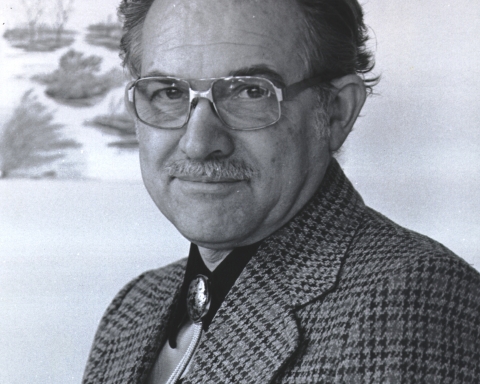The Hyde Park Deltas – Part two
thecatskillgeologist.com
Robert and Johanna Titus
Nov. 2016
_____
This is the second of two new articles about the Hyde Park deltas.
Last time, we began investigating the Hyde Park Deltas. These ice age features have been recognized by glacial geologists for decades and they are seen on the New York State Museum’s map of New York State glacial geology. That map recognizes two deltas. But we have found something remarkable and, we feel, revealing. Those two deltas represent two chapters of delta formation. That needs to be explained. So – we are going to, herein, record the sequence of events that we have deduced to, we hope, explain all this. We are, in short, going to record a sequential history of the formation of the Hyde Park Deltas – and thus Hyde Park itself.
1) It all began sometime close to the end of the Ice Age. The Hudson Valley glacier had been melting and vacating the valley, and it left behind a sizable lake. That has long been recognized as Glacial Lake Albany. The lake stretched across the Hudson Valley and, at Hyde Park, it was nearly two miles wide.
2) Crum Elbow Creek was flowing south by southwest, east of, and parallel to, the lake. This took it across a newly deglaciated landscape. We suspect that, at least at first, it was a far more powerful stream than it is today. It does not amount to much today, but back then, it may have been swollen with very dirty meltwater. It, we think, it (must) have been a very erosive stream.
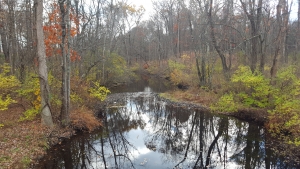
Crum Elbow Creek today, upstream.
3) If so, then Crum Elbow Creek had to have carried a very substantial load of sediment which came to be deposited in Lake Albany. Most of that sediment formed what we are calling the Roosevelt Delta (see yellow on our map). The waters of Lake Albany, at that time, reached a level of 180 feet in modern elevation. The delta’s topset was, likewise, at today’s 180 feet.
The Hyde Park deltas; Roosevelt Delta in yellow; Vanderbilt Delta in brown.
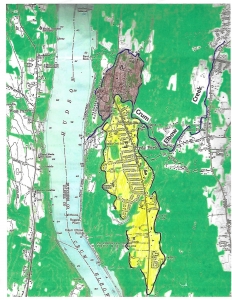
4) We conclude that, back then, Crum Elbow Creek did not turn sharply to the west as it does today. Instead, it continued its southwest path which took it past today’s Wallace Center and onward, just a little north of the Roosevelt mansion, Springwood. Its old channel can still be seen adjacent to the parking lot at the Wallace Center (see map and see photo). This is the time when the stream deposited the Roosevelt Delta (again, see our map).
“Old” Crum Elbow Creek, highlighted in red. “New” Crum Elbow Creek (blue) extends off to the west.
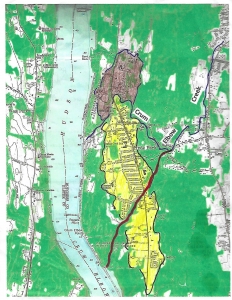
Now dry channel of “Old” Crum Elbow Creek, just north of Wallace Center. “Old” Crum Elbow Creek once flowed at the bottom of this small valley.
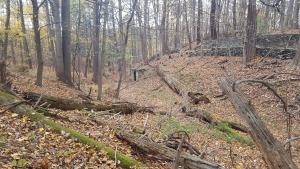
5) Next, there came a time when Lake Albany (suddenly?) drained down to a level of 170 feet. We do not know why, but with that lowering, a remarkable event ensued. A small stream, one that had just begun flowing along the northern edge of the Roosevelt Delta, became quite erosive and, by headward erosion, it worked its way up along that northern flank of the Roosevelt Delta. Stream piracy was now occurring. The path of this stream, “New” Crum Elbow Creek, can be followed along East Market Street (aka County Route 41). It can be seen that this stream had been erosive enough to cut down into the bedrock there (see our photo) and create something of a canyon.
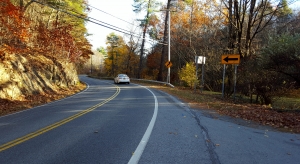
East Market Road follows canyon of “New” Crum Elbow Creek. The creek is just out of sight on the far right; it presumably cut the steep slopes of this canyon.
6) With time, this growing creek would intersect “Old” Crum Elbow Creek and divert its waters into the present-day path of “New” Crum Elbow Creek. Also, a new delta, our “Vanderbilt” Delta, began to form. This younger episode of delta building apparently did not last as long as the previous one, and the new delta never got to be as large as its predecessor. The old Roosevelt Delta leveled off at 180 feet; the new Vanderbilt one at 170.
7) During the period of stream piracy, “Old” Crum Elbow Creek continued flowing in its old path. But that path was about ten feet higher above the new level of Lake Albany. This higher level promoted active erosion of the “Old” Crum Elbow channel. This old channel is the one visible just north of the Wallace Center parking lot. More of the old channel can be traced through Hyde Park.
More channel of “Old” Crum Elbow Creek (left center) on the Yellow Trail at the Winnakee Nature Preserve, just north of Rte. 9.
8) After stream Piracy was complete, the “Old” Crum Elbow channel was left high and dry as is seen at the Wallace Center today (our photo, above). Another dry channel can be seen immediately north of the old Roosevelt family stables. (See our photo below). That had been a tributary of Old Crum Elbow Creek.
Dry canyon of a tributary of Old Crum Elbow Creek, just north of Roosevelt family stables on the Cove Trail.
Sometime later, Lake Albany dropped the remaining 170 feet, down to its present level. Today’s “New” Crum Elbow Creek came into its modern form by eroding those 170 feet. This is best seen where the bridge crosses the creek at the south end of the Vanderbilt Estate.
Crum Elbow Creek at the Vanderbilt Estate.
We believe that this history accounts for pretty much all the landscapes we see, today, at Hyde Park. It is an account that describes the very origins of Hyde Park itself and is thus a fascinating history. We invite you to tour the town and see the geologic sites that we describe here. Then, take Rte. 9, north and south of Hyde Park, and see what the vicinity would have looked like if the deltas had never formed.
We have long been impressed with how ice age events explain so much of what we see in our scenic Hudson Valley. This is a fine example.

